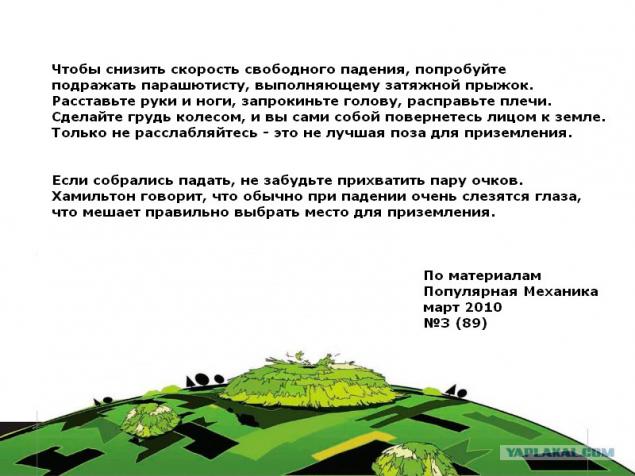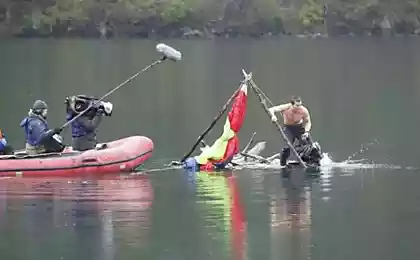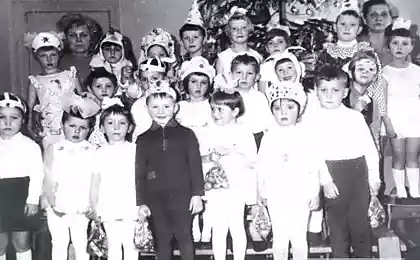740
Survival Guide in the fall to 10 km!
Survival Guide in the fall with a ten-height.
The rate of incidence - 190 km / h, the fall - 3 minutes.

6:59:00 height of 10 000 meters.
Your flight can be called a late night, and want - the early morning. After you take off it was attached to sleep, and suddenly wake up from the burning of icy wind. And the sound - a heart-rending, deafening roar. "Where I am? - You think. - And what happened to the plane? »
You are a ten-altitude above the ground. In complete loneliness. And fall.
The situation is bad. But now it would be better to focus on the positive aspects (not counting the main thing - that you are at least somehow managed to survive a plane). Gravity is now your worst enemy, but you have another ally - time. Believe it or not, your current position is much better than if you fell from the balcony of the fifth floor. More specifically, your position will be better. In the meantime, problems with the oxygen at that altitude hypoxia and lead to loss of consciousness, and a couple of kilometers you will fall like a brick. Then consciousness comes back, and only then try to remember this article. However, in any case, the final stop, that is the ground, you can not miss.
It makes no sense to argue that the chances of surviving a fall from a height of ten-not so much, but at this point you still have nothing to do and no one bothers to think about their own situation. Fall off the plane in two ways. The first of them - a free fall without any attempts to slow its flight. Second - to play the role of "the rider from the wreckage." This term coined by Jim Hamilton, Massachusetts amateur historian who created the page "researchers free fall." This extensive database, which includes nearly all of the cases fall from a great height. "Rider" in his terminology is called the one who managed to grab some chip. For example, in 1972 the Serbian flight attendant Vesna Vulovic serves the DC-9 aircraft. Over Czechoslovakia plane exploded. Stewardess flew 10 kilometers, being sandwiched between his seat, a trolley from the buffet and the body of another crew member. She landed on a snow-covered hillside and to a standstill for a long time on it glided. As a result, she was seriously injured but survived.
If you are surrounded by something like a cocoon from the wreckage, the probability of survival when hitting the ground will be much higher. This is the opinion of Hamilton, based on credible statistics. Since the 1940s, 31 registered a case. Those who survived after a single coast, far fewer - only 13 recorded cases, or credible. Superstar in this fantastic club can be considered lucky military pilot from New Jersey Alan Magee. In 1943, when he served as a combat mission in the skies of France, he was thrown from the plane B-17. Flying 6km, he struck the roof of the train station. Almost immediately he was taken prisoner by the Germans, who were shocked to see him alive.
So far, forget that you are free to fall or could cling to any fragment of the fuselage. The first thing you should be interested in the "ultimate speed" (aka "the steady rate of fall"). The strength of the Earth's gravity pulls you down and tends to disperse. On the other hand, like any other moving object, you meet a "drag" that increases with your speed. At some point, these forces are balanced, and the acceleration is stopped, that is, you go to "set the speed».
Depending on your weight, size and density of the surrounding air, you must be dispersed to not more than 200 km / h, and it will happen just five hundred meters of the coast. That is a fall from a skyscraper or a ten-altitude, you hit the ground with the same force. But from the roof of a skyscraper to the sidewalk, you fly so far in 12 seconds, while falling from the "airplane" height have time to read the whole article. 7:00:20 height of 6,500 meters.
At this point, you have already gone down in those layers of the atmosphere, where you can more or less freely breathe. To you back out. Before hitting the ground is two minutes. Your next task - to decide whether you want to live. If yes, please note that as a joke paratroopers, "do not die from the fall, and from the landing».
Without losing his presence of mind, try to aim.
Where to aim? Magee crashed on the stone floor station, but his fall slowed down when he a moment before it struck the glass roof. It hurts, but salutary. Amiss and the haystack. Some lucky ones survived, landed in the thick bush. Covert - too bad, although you can run into some bitches. Snow? Just perfect. Swamp? Soft covered bog vegetation - the most desirable option. Hamilton talks about when skydiver with unopened parachute landed right on the high-voltage wires. The wires spring back and flipped it up, saving his life. The most dangerous surface - water. Like concrete, it is virtually incompressible. The result of the fall in the ocean surface will be about the same as on the sidewalk. The only difference is that the asphalt - alas! - Not be revealed under you to permanently absorb the broken body.
Not losing sight of the intended target, get your body position. To reduce the rate of fall, act as a paratrooper in the long jump. Raskinte wider legs and arms, zaprokinte higher head, straighten shoulders, and you turn around on their own chest to the ground. Your drag will increase immediately, and there will be room to maneuver. The main thing - do not relax. Your openly say quandary question of how to prepare for a meeting with the earth remains, unfortunately, has not been fully resolved. The journal War Medicine from 1942 published an article on this topic. It said: "In an attempt to avoid injury plays an important role distribution of loads and their compensation." Hence the recommendation - should be falling flat. On the other hand, the report of 1963, published by the Federal Aviation Agency (FAA), argues that the best for the preservation of life is the classic grouping adopted among skydivers: feet together, knees higher, shins pressed against the thighs. The same source noted that survival in a crash is very conducive natrenirovannosti in such sports as wrestling and acrobatics. Falling on hard surfaces is particularly useful to have some skills in martial arts.
Japanese Yasuhiro Kubo skydiver is trained like this: throw your parachute out of a plane, and then jumps himself. Delaying the process to the limit, he catches up with your gear, put on and then pulling the ring. In 2000, Kubo jumped at an altitude of 3 km and held in a free fall of 50 seconds until the pack caught up with his parachute. All these useful skills can be practiced in a safe environment, such as free-fall simulator - a vertical wind tunnel. However, the trainers will not allow you to work out the most important stage - meeting with the land.
If you are waiting for the bottom surface of the water, prepare for quick and decisive action. According to survivors of fans jumping from a high bridge, we can conclude that the best would be the entrance into the water, "soldier", that is feet first. Then you will have at least some chance to get to the surface alive.
On the other hand, the famous divers from the rocks, hone their skills far from Acapulco, believe that it is better to enter the water head first. This hand woven with the fingers they put in front of his head, protecting it from the impact. You can choose any of these positions, but try to the very last second to keep pancakes position. Then, over the water, if you prefer to dive into "soldier", we strongly recommend you to go all out to stretch the buttocks. Explain why it would not be too well, but you probably can guess, and.
Whatever surface you either waited at the bottom, in any case does not land on his head. Researchers from the Institute of Road Safety concluded that in such situations the main cause of death is head injury. If you still bears the head forward, better land on his face. It is safer than a blow back of the head or the upper part of the skull. 7:02:19 height of 300 meters.
If, after falling from an airplane, you do reading this article, it has now come down to just these lines. Initial course you already have, and now it's time to pull himself together and concentrate on your tasks. However, here's something else what additional information
Statistics show that in the event of a disaster is more profitable to be a crew member or a child, and if there is a choice, it is better to endure the crash of a military aircraft. Over the past 40 years, recorded at least 12 air crashes, when in live there was only one person. In this list were four crew members and seven - passenger under the age of 18 years. Among the survivors, Mohammed el-Fa-those Osman year-old child, who survived the crash, "Boeing" in the Sudan in 2003, landing among the debris. Last June, when far away from the Comoros crashed liner Yemenia Airways, survived only 14-year-old Bahia Bakari.
Surviving crew members can be linked to more reliable passive safety systems, and that's why most children are still alive - is not clear. The FAA study notes that children, especially those under the age of four years, more flexible bones, muscles are more relaxed, and a higher percentage of body fat, effectively protects the internal organs. People of small stature - if the head does not protrude out of the backs of airplane seats - well protected from flying debris. With a small body weight and lower the rate of fall-established, and the smaller frontal cross section reduces the chance to run into when landing on some sharp object. 7:02:25 height of 0 meters.
So, we come. Strike. Are you still alive? What are your actions? If you have got minor injuries, you can get up and smoke as did Briton Nicholas Alkemeyd, tail gunner machine gun, which in 1944 after falling from a height of six-kilometer landed in snowy thicket. If no joke, the front you will find many more
Recall the case of Juliana Copco. In 1971, on Christmas Eve, she flew on an airplane Lockheed Electra. The airliner exploded somewhere over the Amazon. 17-year-old German woman came to the next morning under the canopy of the jungle. She was strapped to his seat, and all around lay piles of Christmas presents. Wounded, alone, she forced herself not to think about the dead mother. Instead, she focused on the advice of his father, a biologist, "lost in the jungle, you go to the people, following the passage of the water." Digging went along forest streams, which gradually merged into the river. She avoided the crocodile and bashed in shallow water with a stick to scare away stingrays. Somewhere, I stumbled, lost her shoe, clothes on it was only a torn miniskirt. From food when it was just a bag of candy, and drinking had a dark, dirty water. She ignored the broken collarbone and inflamed open wounds.
On the tenth day, moving along the river Shebonya she saw dragged out to the beach the canoe. It took several hours to climb the slope of the shore to the hut, where she discovered the next day a team of lumberjacks. In Peru, this case was seen as a miracle. Indeed, according to the statistics service ACRO, fixing all of the crash, from 1940 to 2008 as a result of the collapse of 15,463 aircraft killed 118,934 humans. Even if we add to this the number of skydivers who parachute did not open, just 157 lucky people are able to talk about what happened to them a miracle. Of these, 42 - survived after falling from a height of more than 3 km.
True, young Copco did not agree with the fact that her salvation - is the result of a miracle. When she tumbled through the air with his chair, the situation was not in her power, but when she woke up on the ground, she confidently took charge of their lives into their own hands. "I was able to make the only right decision - to leave the scene of the disaster." On parental biostation she received necessary for the survival experience and then told me: "I was not scared. I was taught to go through the forests and how to behave on the river. I had to swim among many dangerous animals such as caimans and piranhas ».
Now congratulations on the happy landing! You have woken up, and the wheels of your aircraft rolling down the runway. You understand that it is unlikely you will ever need in life information from the article. And yet - do not you leave it in the pocket on the back seat next to the passenger? And finally ...)

Source:
The rate of incidence - 190 km / h, the fall - 3 minutes.

6:59:00 height of 10 000 meters.
Your flight can be called a late night, and want - the early morning. After you take off it was attached to sleep, and suddenly wake up from the burning of icy wind. And the sound - a heart-rending, deafening roar. "Where I am? - You think. - And what happened to the plane? »
You are a ten-altitude above the ground. In complete loneliness. And fall.
The situation is bad. But now it would be better to focus on the positive aspects (not counting the main thing - that you are at least somehow managed to survive a plane). Gravity is now your worst enemy, but you have another ally - time. Believe it or not, your current position is much better than if you fell from the balcony of the fifth floor. More specifically, your position will be better. In the meantime, problems with the oxygen at that altitude hypoxia and lead to loss of consciousness, and a couple of kilometers you will fall like a brick. Then consciousness comes back, and only then try to remember this article. However, in any case, the final stop, that is the ground, you can not miss.
It makes no sense to argue that the chances of surviving a fall from a height of ten-not so much, but at this point you still have nothing to do and no one bothers to think about their own situation. Fall off the plane in two ways. The first of them - a free fall without any attempts to slow its flight. Second - to play the role of "the rider from the wreckage." This term coined by Jim Hamilton, Massachusetts amateur historian who created the page "researchers free fall." This extensive database, which includes nearly all of the cases fall from a great height. "Rider" in his terminology is called the one who managed to grab some chip. For example, in 1972 the Serbian flight attendant Vesna Vulovic serves the DC-9 aircraft. Over Czechoslovakia plane exploded. Stewardess flew 10 kilometers, being sandwiched between his seat, a trolley from the buffet and the body of another crew member. She landed on a snow-covered hillside and to a standstill for a long time on it glided. As a result, she was seriously injured but survived.
If you are surrounded by something like a cocoon from the wreckage, the probability of survival when hitting the ground will be much higher. This is the opinion of Hamilton, based on credible statistics. Since the 1940s, 31 registered a case. Those who survived after a single coast, far fewer - only 13 recorded cases, or credible. Superstar in this fantastic club can be considered lucky military pilot from New Jersey Alan Magee. In 1943, when he served as a combat mission in the skies of France, he was thrown from the plane B-17. Flying 6km, he struck the roof of the train station. Almost immediately he was taken prisoner by the Germans, who were shocked to see him alive.
So far, forget that you are free to fall or could cling to any fragment of the fuselage. The first thing you should be interested in the "ultimate speed" (aka "the steady rate of fall"). The strength of the Earth's gravity pulls you down and tends to disperse. On the other hand, like any other moving object, you meet a "drag" that increases with your speed. At some point, these forces are balanced, and the acceleration is stopped, that is, you go to "set the speed».
Depending on your weight, size and density of the surrounding air, you must be dispersed to not more than 200 km / h, and it will happen just five hundred meters of the coast. That is a fall from a skyscraper or a ten-altitude, you hit the ground with the same force. But from the roof of a skyscraper to the sidewalk, you fly so far in 12 seconds, while falling from the "airplane" height have time to read the whole article. 7:00:20 height of 6,500 meters.
At this point, you have already gone down in those layers of the atmosphere, where you can more or less freely breathe. To you back out. Before hitting the ground is two minutes. Your next task - to decide whether you want to live. If yes, please note that as a joke paratroopers, "do not die from the fall, and from the landing».
Without losing his presence of mind, try to aim.
Where to aim? Magee crashed on the stone floor station, but his fall slowed down when he a moment before it struck the glass roof. It hurts, but salutary. Amiss and the haystack. Some lucky ones survived, landed in the thick bush. Covert - too bad, although you can run into some bitches. Snow? Just perfect. Swamp? Soft covered bog vegetation - the most desirable option. Hamilton talks about when skydiver with unopened parachute landed right on the high-voltage wires. The wires spring back and flipped it up, saving his life. The most dangerous surface - water. Like concrete, it is virtually incompressible. The result of the fall in the ocean surface will be about the same as on the sidewalk. The only difference is that the asphalt - alas! - Not be revealed under you to permanently absorb the broken body.
Not losing sight of the intended target, get your body position. To reduce the rate of fall, act as a paratrooper in the long jump. Raskinte wider legs and arms, zaprokinte higher head, straighten shoulders, and you turn around on their own chest to the ground. Your drag will increase immediately, and there will be room to maneuver. The main thing - do not relax. Your openly say quandary question of how to prepare for a meeting with the earth remains, unfortunately, has not been fully resolved. The journal War Medicine from 1942 published an article on this topic. It said: "In an attempt to avoid injury plays an important role distribution of loads and their compensation." Hence the recommendation - should be falling flat. On the other hand, the report of 1963, published by the Federal Aviation Agency (FAA), argues that the best for the preservation of life is the classic grouping adopted among skydivers: feet together, knees higher, shins pressed against the thighs. The same source noted that survival in a crash is very conducive natrenirovannosti in such sports as wrestling and acrobatics. Falling on hard surfaces is particularly useful to have some skills in martial arts.
Japanese Yasuhiro Kubo skydiver is trained like this: throw your parachute out of a plane, and then jumps himself. Delaying the process to the limit, he catches up with your gear, put on and then pulling the ring. In 2000, Kubo jumped at an altitude of 3 km and held in a free fall of 50 seconds until the pack caught up with his parachute. All these useful skills can be practiced in a safe environment, such as free-fall simulator - a vertical wind tunnel. However, the trainers will not allow you to work out the most important stage - meeting with the land.
If you are waiting for the bottom surface of the water, prepare for quick and decisive action. According to survivors of fans jumping from a high bridge, we can conclude that the best would be the entrance into the water, "soldier", that is feet first. Then you will have at least some chance to get to the surface alive.
On the other hand, the famous divers from the rocks, hone their skills far from Acapulco, believe that it is better to enter the water head first. This hand woven with the fingers they put in front of his head, protecting it from the impact. You can choose any of these positions, but try to the very last second to keep pancakes position. Then, over the water, if you prefer to dive into "soldier", we strongly recommend you to go all out to stretch the buttocks. Explain why it would not be too well, but you probably can guess, and.
Whatever surface you either waited at the bottom, in any case does not land on his head. Researchers from the Institute of Road Safety concluded that in such situations the main cause of death is head injury. If you still bears the head forward, better land on his face. It is safer than a blow back of the head or the upper part of the skull. 7:02:19 height of 300 meters.
If, after falling from an airplane, you do reading this article, it has now come down to just these lines. Initial course you already have, and now it's time to pull himself together and concentrate on your tasks. However, here's something else what additional information
Statistics show that in the event of a disaster is more profitable to be a crew member or a child, and if there is a choice, it is better to endure the crash of a military aircraft. Over the past 40 years, recorded at least 12 air crashes, when in live there was only one person. In this list were four crew members and seven - passenger under the age of 18 years. Among the survivors, Mohammed el-Fa-those Osman year-old child, who survived the crash, "Boeing" in the Sudan in 2003, landing among the debris. Last June, when far away from the Comoros crashed liner Yemenia Airways, survived only 14-year-old Bahia Bakari.
Surviving crew members can be linked to more reliable passive safety systems, and that's why most children are still alive - is not clear. The FAA study notes that children, especially those under the age of four years, more flexible bones, muscles are more relaxed, and a higher percentage of body fat, effectively protects the internal organs. People of small stature - if the head does not protrude out of the backs of airplane seats - well protected from flying debris. With a small body weight and lower the rate of fall-established, and the smaller frontal cross section reduces the chance to run into when landing on some sharp object. 7:02:25 height of 0 meters.
So, we come. Strike. Are you still alive? What are your actions? If you have got minor injuries, you can get up and smoke as did Briton Nicholas Alkemeyd, tail gunner machine gun, which in 1944 after falling from a height of six-kilometer landed in snowy thicket. If no joke, the front you will find many more
Recall the case of Juliana Copco. In 1971, on Christmas Eve, she flew on an airplane Lockheed Electra. The airliner exploded somewhere over the Amazon. 17-year-old German woman came to the next morning under the canopy of the jungle. She was strapped to his seat, and all around lay piles of Christmas presents. Wounded, alone, she forced herself not to think about the dead mother. Instead, she focused on the advice of his father, a biologist, "lost in the jungle, you go to the people, following the passage of the water." Digging went along forest streams, which gradually merged into the river. She avoided the crocodile and bashed in shallow water with a stick to scare away stingrays. Somewhere, I stumbled, lost her shoe, clothes on it was only a torn miniskirt. From food when it was just a bag of candy, and drinking had a dark, dirty water. She ignored the broken collarbone and inflamed open wounds.
On the tenth day, moving along the river Shebonya she saw dragged out to the beach the canoe. It took several hours to climb the slope of the shore to the hut, where she discovered the next day a team of lumberjacks. In Peru, this case was seen as a miracle. Indeed, according to the statistics service ACRO, fixing all of the crash, from 1940 to 2008 as a result of the collapse of 15,463 aircraft killed 118,934 humans. Even if we add to this the number of skydivers who parachute did not open, just 157 lucky people are able to talk about what happened to them a miracle. Of these, 42 - survived after falling from a height of more than 3 km.
True, young Copco did not agree with the fact that her salvation - is the result of a miracle. When she tumbled through the air with his chair, the situation was not in her power, but when she woke up on the ground, she confidently took charge of their lives into their own hands. "I was able to make the only right decision - to leave the scene of the disaster." On parental biostation she received necessary for the survival experience and then told me: "I was not scared. I was taught to go through the forests and how to behave on the river. I had to swim among many dangerous animals such as caimans and piranhas ».
Now congratulations on the happy landing! You have woken up, and the wheels of your aircraft rolling down the runway. You understand that it is unlikely you will ever need in life information from the article. And yet - do not you leave it in the pocket on the back seat next to the passenger? And finally ...)

Source:























